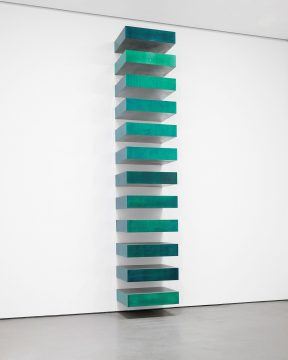Peter Schjeldahl at The New Yorker:
 I would tell you my emotional responses to the gorgeous works in the Donald Judd retrospective that has opened at the Museum of Modern Art if I had any. I was benumbed, as usual, by this last great revolutionary of modern art. The boxy objects (he refused to call them sculptures) that Judd constructed between the early nineteen-sixties and his death, from cancer, in 1994, irreversibly altered the character of Western aesthetic experience. They displaced traditional contemplation with newfangled confrontation. That’s the key trope of Minimalism, a term that Judd despised but one that will tag him until the end of time. In truth, allowing himself certain complexities of structure and color, he was never as radically minimalist as his younger peers Dan Flavin (fluorescent tubes) and Carl Andre (units of raw materials). But Judd, a tremendous art critic and theorist, had foreseen the change (imagine, in theatre, breaking the fourth wall permanently) well before his first show of mature work, in 1963, when he was thirty-five. Slowly, by erosive drip through the nineteen-sixties and seventies, the idea that an exhibition space is integral to the art works that it contains took hold. It is second nature for us now—so familiar that encountering Judd’s works at moma may induce déjà vu.
I would tell you my emotional responses to the gorgeous works in the Donald Judd retrospective that has opened at the Museum of Modern Art if I had any. I was benumbed, as usual, by this last great revolutionary of modern art. The boxy objects (he refused to call them sculptures) that Judd constructed between the early nineteen-sixties and his death, from cancer, in 1994, irreversibly altered the character of Western aesthetic experience. They displaced traditional contemplation with newfangled confrontation. That’s the key trope of Minimalism, a term that Judd despised but one that will tag him until the end of time. In truth, allowing himself certain complexities of structure and color, he was never as radically minimalist as his younger peers Dan Flavin (fluorescent tubes) and Carl Andre (units of raw materials). But Judd, a tremendous art critic and theorist, had foreseen the change (imagine, in theatre, breaking the fourth wall permanently) well before his first show of mature work, in 1963, when he was thirty-five. Slowly, by erosive drip through the nineteen-sixties and seventies, the idea that an exhibition space is integral to the art works that it contains took hold. It is second nature for us now—so familiar that encountering Judd’s works at moma may induce déjà vu.
more here.
